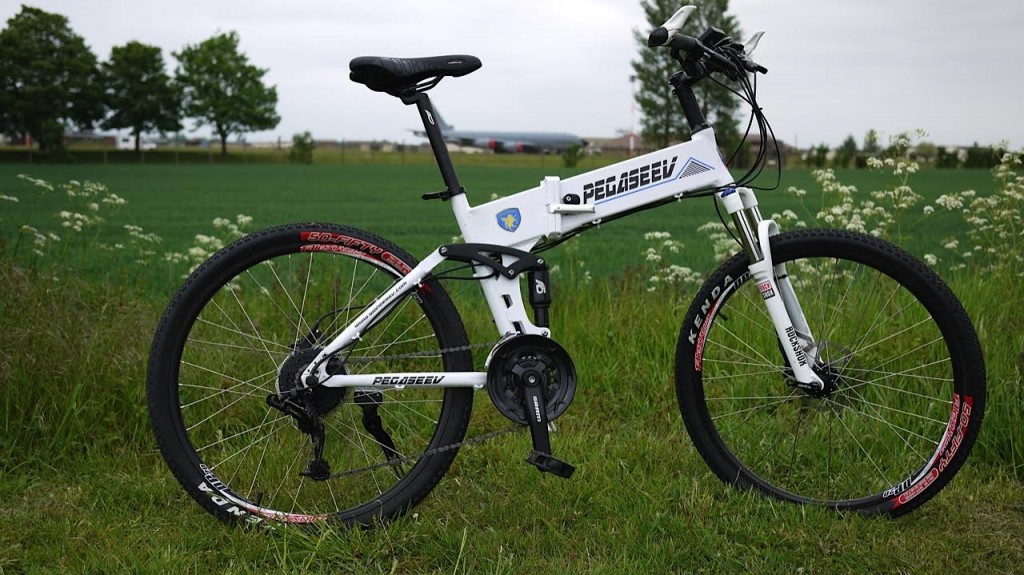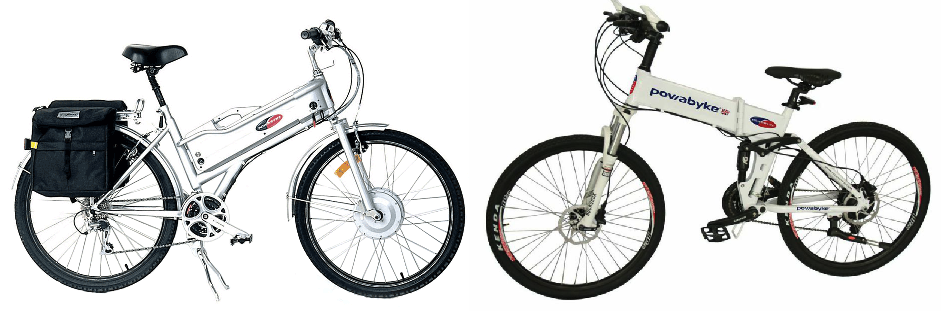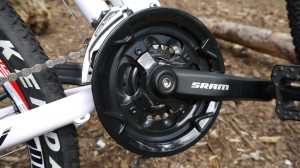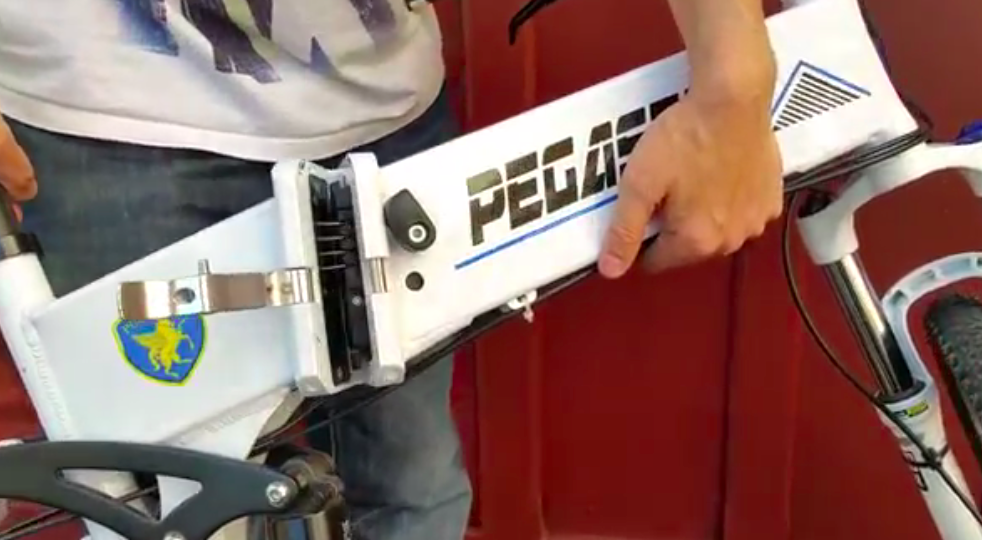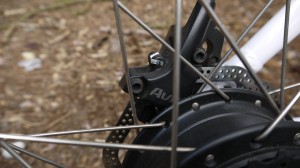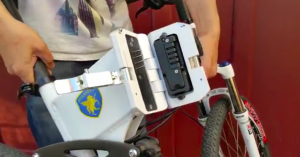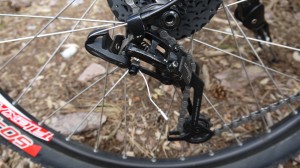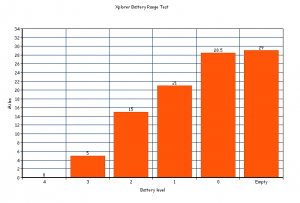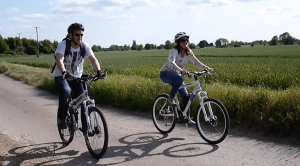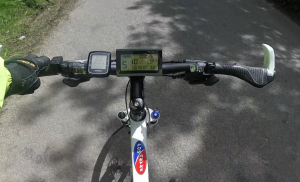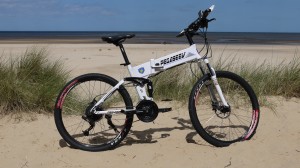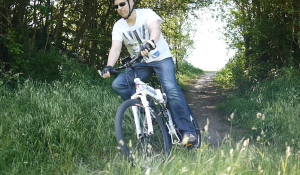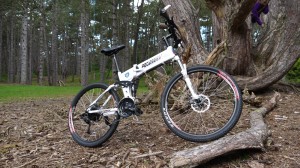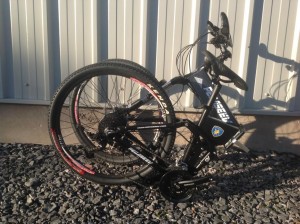An electric folding mountain bike? We review the Xplorer from Powabyke.
A little bit about Powabyke
Powabyke are one of the oldest electric bike importers in the UK, having started in 1999. More recently, in 2013 long-time employees, Frank Curran and Keith Palmer, took over the company. Powabyke have sold thousands of bikes over the years.
In fact, it was the Powabyke Commuter 24 that first introduced me to the world of e-bikes back in 2004. It was a bit of a brute-force approach to electric cycling with the huge SLA battery in the frame, but it had plenty of oomph to get up those hills and a fairly decent range for its time. The Commuter has a bit of a passing resemblance, although not intentional, to the bike I am reviewing here – the Powabyke Xplorer.
The Bike
The Xplorer is unusual in that it is an MTB style bike that folds. While there are a fair few electric folders on the market, they tend to have smaller wheels – anything from 12″ to 20″ – and they are obviously more suited to on-road activities such as short commutes, popping to the shops and so forth. This bike has 26″ wheels, front and rear suspension, hydraulic disk brakes and 24-speed S-RAM gears, so it is definitely suited to more challenging terrain or, as Powabyke put it in their marketing material: “getting dirty!”.
The Xplorer is available through your local Powabyke dealer or directly from the company itself. It currently retails for around £1499. Spare batteries are available at £299 inc VAT. It is available in white or black, but only one frame size.
Powabyke Xplorer Specification:
- Motor power (W): 250
- Motor position: Rear hub
- Motor Description: MXUS XF08 250W brushless hub motor
- Battery: 36V 8Ah Lithium
- Max Range: 50 miles
- Throttle / Pedal Assist: Pedal assist only with Walk mode via control on handlebars
- Suspension: Front and rear. Rock Shox XC28 (front)
- Brakes: Avid hydraulic disk brakes
- Gears: S-RAM X4 rear derailleur and controls, Shimano Tourney front derailleur
- Saddle: Selle Royal Lookin gel
- Wheel Size: 26”
- Tyres: Kenda all-terrain tyres
- Controls: Backlit LCD (not removable) and remote
- Max Speed: 15.5mph
- Weight: 22 kg bike. Battery 2.2kg
For more details on the Powabyke Xplorer specification click here.
What’s in the box
The bike
Manual
Charger + UK AC lead
Battery
Pedals
A set of two keys
The Xplorer came in the usual big brown box almost fully assembled, so the only thing that needed doing was to fit the front wheel, align and tighten the handlebars and attach the pedals. The separate lithium battery fits inside the frame and to get access to it you flick up the small retaining clip and then pull back the larger restraining lever.
The next bit was a little bit tricky the first time around as you have to ‘snap’ the bike open, which reveals the battery hole. It takes a few goes to find a comfortable place for your hands while you perform this manoeuvre. Once you’ve opened the frame, you can grab the battery and push it tight into place. There is a small hinged handle to help you do this. Then you just have to join the two frame sections together again and flick back the clips. Finally you can lock the battery inside the frame, using one of the supplied keys and a small hole underneath.
There are actually two holes, one is for the lock and the other is so you can charge the battery on the bike. Powabyke have placed a small sticker on top of the frame just to help you work out which is which!
There are no other accessories fitted, so no lights or mudguards, therefore if you want these they will have to be after market ones. The bike is fitted with a rear-side stand though, which is always a very useful accessory.
The frame is solid, although I would’ve liked to have seem some internal routing of all the cables given the chunkiness of the frame.
The LCD control unit is fixed to the handlebar, so cannot be removed for security unfortunately.
First impressions: out on the road
With the bike assembled and ready to go, I checked the battery level which showed full, but just to be sure I gave it a quick charge. The charger is the usual brick, this one has a single light showing red/orange while charging and green once fully charged. There’s no fan so it’s silent while charging. A full charge can take up to 4 hours.
After a quick adjustment of the seat height to take into account the ‘drop’ from the rear suspension, I headed out for a quick spin. To turn on the bike, you press and hold the power button on the remote for a second or two.
Setting the PAS to level 5 (the highest setting), the motor kicked in after a pedal revolution. The bike was quite quick off the mark, swiftly accelerating to the cut-off point, which indicated 17.6 mph on the LCD display. My Garmin GPS reported 15.9 mph however, so the cut-off speed limit is within the 10% tolerance of the UK law. A few miles around the local roads and the bike was quite comfortably cruising around the 16mph mark.
The compact MXUS hub motor is fairly quiet in operation, just a gentle hum in the background. If there’s anything more than a gentle breeze, you can’t really hear it unless you turn your head to one side.
The Xplorer comes with SRAM X4, 24 speed rear derailleur and a Shimano Tourney up front. While at the budget end of the market, gear changing was smooth and precise. Under hard pedalling there was no jumping between gears. One of the differences in a hub motor bike compared to the crank-drive bikes (although newer models are now programmed to ease off the power momentarily) is that it is easier to change gear as there is less stress on the chainset.
The bike is also fitted with SRAM Avid hydraulic brakes, although on this bike the positions were reversed so the left lever controlled the front brake and the right the rear.
An LCD display unit in the middle of the handlebars tells you all you need to know about how fast you are going, the battery level, trip information and so on. Usefully, there is a clock and even an outside temperature display! A remote control next to the left grip (so you don’t have to keep taking your hand off the grip) has 3 buttons, an up/down for PAS control and a middle on/off button.
The buttons all have secondary functions. The middle button allows you to scroll through different information on the display or reset trip or change the clock. The ‘up’ button, when held down for several seconds, turns on the backlight – handy for dark nights and winter cycling. The ‘down’ button controls the walk-along function, which also needs to be depressed for a couple of seconds before it kicks in.
Once back to base, I then decided to have a look at the foldability aspect of the bike.
As before, once you flick open the restraining levers you can fold the two sections in half. By resting the rear half against your leg, you can put the front half towards you until they are side by side. Unless you’ve locked the battery in place, it’s wise to remove it at this point. Underneath the front chainwheel there is a small stand welded onto the frame which can support the bike while you open the boot of your car, for example. I managed to get the bike to fit easily in the back of a Ford Galaxy, it was bit tighter in a 3-series estate, so you may need to loosen the handlebars too so they can sit parallel to the frame. At 24Kg+ with the battery though, you’ll need a good back and a decent pair of biceps!
Range test
With a full charge overnight, the next day I headed out to test the range of the battery. Conditions were mainly dry and overcast, but there was a strong breeze. Where we live is mainly flat, so there were no real hills to speak of during the test but it is quite open to the elements.
Starting off with 4 full bars showing on the LCD display, for this test I used the maximum power setting (5) and rode at that maximum cut-off speed until the battery was empty.
When the first bar went on the battery level, I had covered just over 5 miles. The second bar went at 15 miles and the third at 21 miles. At this point I headed back towards home. With 0 bars left on the display, my Garmin was telling me I had covered just over 28.5 miles. There was a fairly strong headwind for about a 1/3rd of the ride so you should be able to hit the low 30s comfortably and more if you’re prepared to drop the power level and top speed, although bear in mind if you live in a particularly hilly area these numbers will be significantly affected. Powabyke on their website are quoting 20-50 miles and as with all quoted figures, you can only really get a true feel for range when you actually put the bike to use in your terrain, with your weight, general fitness, riding style and how much effort you want to put in. I am 6’1″ and around 92kg.
Once all bars disappeared, the battery level started flashing to indicate almost out of power. Continuing on, I managed to go a further 0.5 miles before the power cut out. At this point I was on my own so luckily there were just a few hundred yards to go. With the power still on, occasionally the assistance would come back on once the cells had rested for a minute or so.
While there is a battery level indicator on the display, there is no range given so you’ll need to test the bike in your own conditions and make a mental note of the average range you’ll get through the ‘bars’.
Hill Climbing Test
Living in a rather flat part of the UK, it’s a challenge to find any decent hills without driving for a few hours. Back to Hartest Hill therefore, which I have used before for my hill climb test, which is a 1/4 mile climb and about 17% incline at its steepest section.
The first test was to use maximum power setting (PAS 5) and get up the hill as quickly as possible. As before the bike was swift off the mark and I managed to keep up a good pace going up the hill. The steepest section is the final 3rd, at which point my top speed dropped a bit, but it still got up the hill OK.
My average speed for this climb was 9.5mph with a maximum speed of 12.3mph.
Whizzing back down to the bottom of the hill again for a re-test, the decline is steep enough to hit over 45mph with barely any pedalling, but the bike felt safe and the Avid disk brakes felt reassuring when slowing down. While more at the budget end of market, they had plenty of stopping power and were smooth throughout.
Next up, maximum power PAS 5 and slow as possible. This one was a bit trickier to do. There is no torque-sensor on this bike, so it is all or nothing. On level 5, it was difficult to pedal slowly as the motor was feeding all its power into the wheel, so it felt like I wasn’t putting any effort in at all and was just going through the motions of pedalling. So on the hills, to control this, you’ll need to use the handlebar mounted switch to increase or decrease the assistance level, taking into account the incline and amount of effort you are prepared to put in.
On one of the hill climbs I hadn’t selected the correct gear so had to change half-way up. Stopping pedalling meant the power dropped off immediately and it took a revolution or so before it kicked back in. However, due to the steepness of the incline it was difficult to get going again.
The final climb I turned off the power and relied on leg power alone. With approaching 25kg of bike, it was never going to be easy and at the halfway point, it was a case of bum out of the seat. Once I’d reached the top, I was reminded just how much difference an electric bike can make on the hills!
While heading off for a ride after the hill tests, I noticed that power suddenly dropped out and the display turned off. I pulled over to the side of the road and was unable to power the bike on again. I checked over the battery which had unfortunately packed up, so that ended the testing for the day. On my return, I fired off an email to Keith at Powabyke and a new battery was swiftly despatched the next day. Thankfully, this replacement battery has performed flawlessly for the remainder of the test period. I’ll report back once the battery has been returned to Powabyke to establish what the fault was. Powabyke do say that all their batteries come with a 2 year warranty.
We did a separate small test against a Bosch crank driven bike and allowing for rider weight differences they were fairly evenly matched.
Off-Road
While the Xplorer is marketed as an off-road bike, it is more an off-road ‘style’ i.e. not really suited for extreme conditions. It does have Rock Shox XC28 forks, these are more suited for trails. On the rear, the bike is fitted with a 125mm Exa Form A5-RE air suspension, manufactured by Kind Shock. While aimed at trails/light cross with a short travel, it handled my weight and the various obstacles, especially going down hill and on rough surfaces.
We took the bike up to the north Norfolk coast for some testing. Wells’ coastline changes from miles of open white sandy beach, into sand dunes that then run into the undulating terrain of the pine forest that provided a different challenge for the Xplorer. With lots of steep climbs and drops, sand and tree roots there were plenty of obstacles to put the bike through.
Summary
I was pleasantly surprised with the Xplorer. With bikes that are ‘different’ something is usually lost in the translation but it turned out to be a good performer, was very sturdy and comfortable to ride. I certainly appreciated the rear suspension (even if it is entry level) once I got back onto my Specialized hardtail. The gel saddle was comfortable along with the overall riding position. The LCD display is easy to read and has all the information you need.
Negatives were the battery rattling inside the frame, especially noticeable off-road which was annoying as the rest of the bike was quiet. Perhaps some insulating material inside might help. A torque sensor would be good improvement, which would help on the hill climbs.
Should you buy one?
I thought the the Xplorer would be an unusual bike to review, in that it probably suits a specific person, which in turn would limit the customer base. (There isn’t anything unusual in this, a lot of e-bikes are design for specific lifestyles, pinpointing certain demographics.) However, the more I thought about it, the more I realised how the portability of this bike opens it up to a larger range of potential customers with the practicalities that offers, rather than limiting it.
Someone who drives a car for instance, but wants to carry a bike in the boot to go for a ride off-road/trails when they’re in the mood or conditions suit them. Others might not want to, or be able to, fit a bike rack on the car. If you don’t want to leave the bike unattended or locked somewhere, you can fold this and store it in the boot.
Usually for me at weekends, it’s a case of bike or kids in the car so the portability aspect mean I could take both. Also having to do a fair bit of driving, there were times I drove past an area and thought ‘ooh I’d like to have a ride around there’. With this bike in the back, I could.
The closest analogy I can think of is ‘the best camera is the one you have with you’, in as much as a bike that offers greater flexibility in terms of being more easily stored and ported around, is likely to be used more.
So there are plenty of weekend and leisure cycling possibilities with this folding e-bike.
Folders also open up commuting options too, although this is a fairly heavy bike to be carrying up stairs into an office.
- + sturdy
- + comfortable to ride
- + handles trails roads etc well
- + folding full-sized bike
- + specification
- – would’ve liked a torque sensor
- – rattling of the battery off-road
- – not light to carry when folded – you’ll need some decent biceps for this one.
- – no brake cut outs
Where to buy?
Available from Powabyke dealers and direct from Powabyke themselves. The Pedelecs’ Xplorer specification can be found here.
Our thanks to Keith and Frank at Powabyke for sending us this bike to review.
You can view some more photos during our test here – Powabyke Xplorer Media. A video review will appear shortly.


